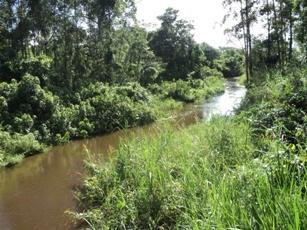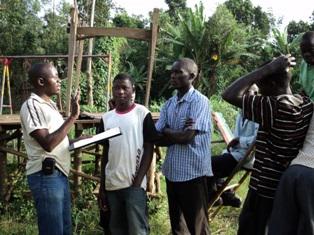Patrick Byamukama Byaruhanga
This project, therefore, is aimed at creating public awareness and participation in the conservation and sustainable management of this wetland.

Wambabya course where the field work is taking place.
Wambabya, one of the largest wetlands in Hoima, covering a stretch of 58 km, is among the wetlands in Uganda that has been reduced to 2% from the initial 13% coverage. It is considered one of the important ecosystems with high biodiversity, ecological and economic values. The wetland is a source of water for over 50,000 people within Hoima Municipality. The wetland faces threats due to anthropogenic activities. They include cultivation, overgrazing, pollution from alcohol distilling and motorcycle/car washing. It is estimated that about 1/4 has been affected significantly by human activity and 14% seriously degraded. The greatest threat to this wetland is its reclamation for agriculture and housing. This has compromised ecological functioning of the wetland in filtering water owing to its loss of biodiversity. This has increased the cost of water treatment for the urban population. Despite the forceful measures the Department of Environment has undertaken, the wetland has continued to face massive encroachment and the effects have escalated. With such a rate of change and the ever increasing human population dependent on already a depleted resource, this calls for conservation education before the resources are driven into depletion.

Patrick meeting with car washers during field interview, part of baseline survey, to establish knowledge on wetlands.
The value of the wetlands in Uganda is being undermined. This project, therefore, is aimed at creating public awareness and participation in the conservation and sustainable management of this wetland.
The project intends to achieve the following objectives:
1. Mobilize and consolidate community based initiatives for the conservation and sustainable management of wetland resources;
2. Promoting public awareness on the conservation of wetland biodiversity;
3. Providing the public with knowledge and understanding on ecological and socio-economic importance of the wetland biodiversity;
4. Providing individuals, communities and groups with opportunities to actively participate in solving wetland problems and making informed decisions about biodiversity conservation.
At the end of or after the project, we hope that: peoples’ bad perceptions and attitudes towards the wetland resource use will have changed and this will promote wise use; degraded patches of the wetland will be restored or reversed; and the principles of wetland conservation will have been instilled in the communities.
The project will run for a period of 12 months and will adopt the following methodology and implement the following activities: baseline survey, presentation of findings, sensitization and awareness, field tours, partnerships and collaboration, formation of Environmental Community Conservation Clubs (ECCCs), Training ECCCs, messaging, mentoring, monitoring and evaluation and report writing.